While the city sleeps: On the road with cops, chasing youth offenders
Police slowly approach, then the car roars to life, racing away from us at speeds of up to 140km/h. Police know the driver is one of their five most active offenders. He is 16.
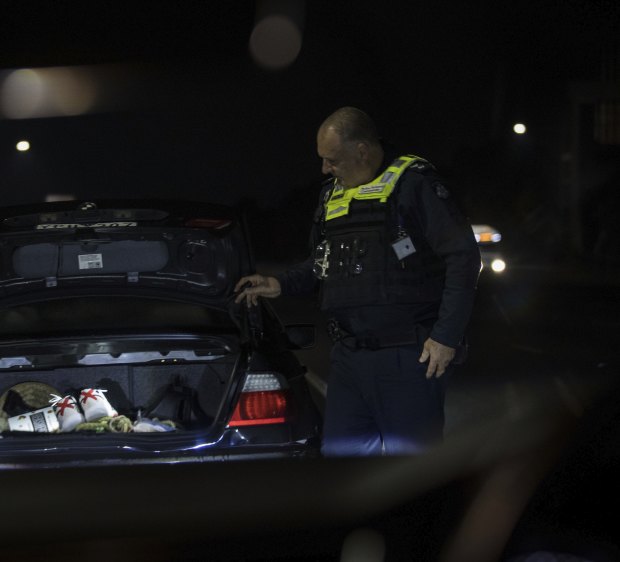
Acting Superintendent Andy McKee pulls over a motorist in the early hours of August 6 as part of Victoria Police’s Operation Trinity, targeting aggravated burglaries and associated car thefts.Credit: Darrian Traynor
It is 1am on a cold Melbourne night. A mist is descending on the arterial roads and traffic is light. But for the police in the Trinity Taskforce, it is approaching peak hour.
Every night 70 police from general duties, dog squad, highway patrol and detective units, backed by the air wing, go hunting. Their prey are young offenders who head out in the darkness to rob homes and businesses, usually in stolen cars.
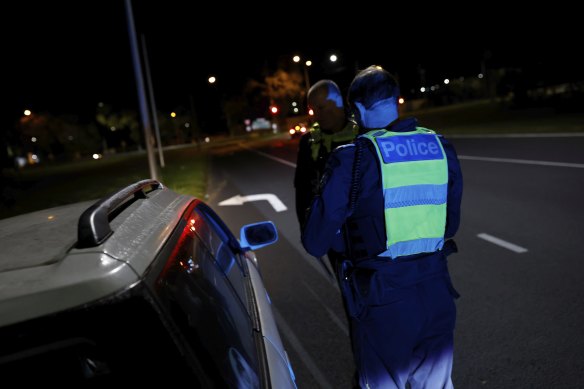
Acting Superintendent Andy McKee and his partner Sergeant Richard Clayton pull over a motorist in the early hours of August 6.Credit: Darrian Traynor
Waiting for us outside the Dandenong police station is 31-year veteran acting Superintendent Andy McKee, who remains as enthusiastic as the day he graduated.
We sit in the station’s intelligence section. A wall of monitors displays CCTV from around the district. It is about getting in front of the game.
McKee, on his third stint at Dandenong, loves policing a busy multicultural district. He returned from a posting in the country. “I went from 30 jobs a week to 30 jobs a shift.”
He says while the community is vibrant, there is no avoiding the fact it has one of the highest crime rates in the state. “Of the top 10 gangs, we have five.”
They are not gangs in the traditional sense, based on location or ethnicity, with African youths unfairly blamed for a disproportionate number of offences.
“It is our Olympics, with everyone represented,” McKee says.
Nor are they at war. Executing a search warrant, police found four teenage boys, each connected with a different local gang, and a girl linked to the fifth.
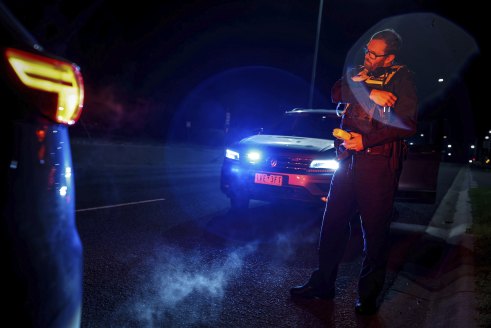
Sergeant Richard Clayton pulls over a car as part of Operation Trinity.Credit: Darrian Traynor
The gangs have names police won’t share. Kudos and notoriety are currency for young offenders, which is why social media is a recruiting tool. McKee says it is called “post and boast”.
They have identified about 300 hardcore young offenders around the state with multiple arrest records.
Police set up Operation Trinity in March last year, and the results are both reassuring and depressing.
Trinity and its sister operations arrest eight young offenders every night, and have made more than 1450 burglary and car theft arrests in 12 months – with 65 per cent of the offenders aged 10 to 17.
Not all the kids are lost causes. There are those who offend once, then don’t come under police notice again. There are others who grow out of it, and others who won’t change.
McKee says that “99.5 per cent of kids are awesome. It is the .5 per cent that are the problem.”
The police strategy is simple, logical and difficult to deliver. A legal version of the carrot and the stick.
Offer multiple paths for young crooks to veer off the road that leads to jail, and if that fails, keep arresting until they give up.
As well as operations such as Trinity, there are crime response teams. McKee says the teams build programs for offenders, which include helping parents, dealing with siblings, regular bail curfew checks and intense monitoring.
The cases that bring the headlines are armed offenders bursting into homes, terrorising families, stealing valuables in the house, then taking the residents’ cars. These crimes are life-altering for victims.
However, McKee says most offenders slip in at night when people are asleep, steal what they can and go. They don’t seek confrontation.
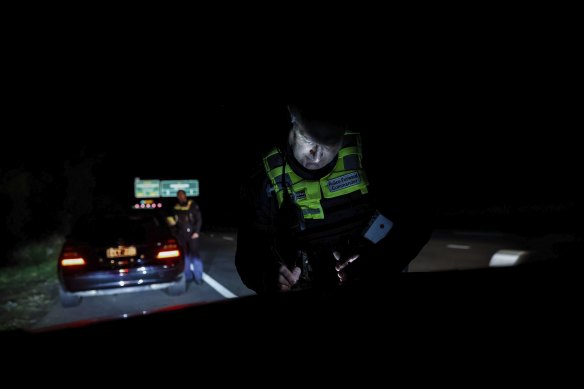
On the road with Acting Superintendent Andy McKee and Sergeant Richard Clayton.Credit: Darrian Traynor
Despite the publicity, in a surprising number of cases the offenders target unlocked cars and houses.
Later that morning on patrol we find an unlocked Porsche parked on the street outside the owner’s house in a red crime zone.
Juvenile offenders are initially attracted to the thrill rather than the spoils.
A staggering 1420 vehicles were stolen during aggravated burglaries in 2023 in Trinity hotspots, with 95 per cent recovered. They’re dumped rather than sold.
The average age of the 20 most prolific offenders is 15, and they commit nearly 20 per cent of aggravated burglaries where vehicles are stolen.
As police tactics evolve, so do the gangs. Adult crooks are using kids as young as 10 as foot soldiers to commit profit-motivated crimes, such as stealing large quantities of cigarettes and alcohol.
“They are tipping into organised crime without knowing it,” says McKee.
Some can’t read and write, and the COVID lockdown hasn’t helped. Isolation, lack of social support and failure to educate means some see crime as their best option.
Cops can become cynical and typecast all offenders as no-hopers. McKee remains positive, preferring to stop crime rather than arrest criminals. He knows cops and courts alone are not the answer. Opportunities, rather than jail, should be the first call.
Not that he is a softie, delivering the message: “Stop offending, or we will do everything to catch you.”
He believes the legal, education, social welfare and employment systems need to work together. “We can arrest them until the cows come home, but there has to be a better way.”
Back on the streets
It is time to hit the road. “If we can grab them on their way or after their first job, we stop multiple offences,” McKee says.
The streets are near-empty but McKee and his partner, Sergeant Richard Clayton, a 34-year veteran stationed at Dandenong for 23 years, start pulling over cars, one without functioning headlights, another struggling with a deflating tyre and others on instinct.
Tactics have changed. When McKee was a young cop, old sedans were the cars usually stolen. Now it’s cars worth over $50,000 that are top of the pops. In the Trinity most-stolen list for 2023 were BMWs (184), Mercedes (180), then VWs (146).
Some can’t read and write, and the COVID lockdown hasn’t helped. Isolation, lack of social support and failure to educate means some see crime as their best option.
The police radio is relatively quiet, but that doesn’t mean there are no offences. Many will not be discovered until residents wake to find the front door open and their cars long gone.
Despite the cops knowing they may be placed in physical danger during the shift, there is banter on the road. McKee, at 190 centimetres, complains he may do his neck getting in and out of the smaller unmarked police car. He puts out a challenge for Trinity units to match his target of pulling over cars, lightly teasing them after each intercept.
We soon learn that McKee and I have mutual friends in the job.
Age photographer Darrian Traynor is in the car. His dad is retired cop Barry, his brother Anthony a serving one. Turns out Clayton went to Anthony’s wedding and Barry was a trainer at the Police Academy when McKee was a recruit.
With no active jobs, we check a house in Endeavour Hills where repeat offenders, aged 16 to 22, reside.
Like bats out for a nighttime feed, the crooks start returning between 4am and 6am. For the cops, it is the second bite of the cherry. If you can’t get them before they commit a crime, get them on the way back.
This is no ghetto. The winding streets are clean, the lawns manicured, hedges clipped and the bins out for collecting. While most homes are in darkness, there is a light on at the rear of our crooks’ house. Who leaves a welcome light on at 4.15am?
We sit in an adjacent small court. A black car rolls up, the driver sees us, plants the foot, switching off the headlights at the same time. McKee estimates speeds between 120km/h and 140km/h in the 40km/h zone.
“We won’t chase. It’s not worth it,” he says. “The risk [to the driver and the public] is not worth the reward.”
When they call the job in, several marked and unmarked units arrive to cruise the quiet suburban pocket. It is now a game of cat and mouse, although the mice are sitting in high-powered stolen cars.
McKee sees the flash of a car light as the parked 2014 Holden Commodore is unlocked, but no one exits the vehicle. We pull up parallel, facing opposite directions. The tactic of parking in front to block a suspicious car has long been abandoned due to a spate of rammings.
Even though the cars are 50 centimetres apart, it is impossible to see through the dark tint. The Commodore roars into life and takes off at speed, reaching 120km/h before veering into a side street and disappearing.
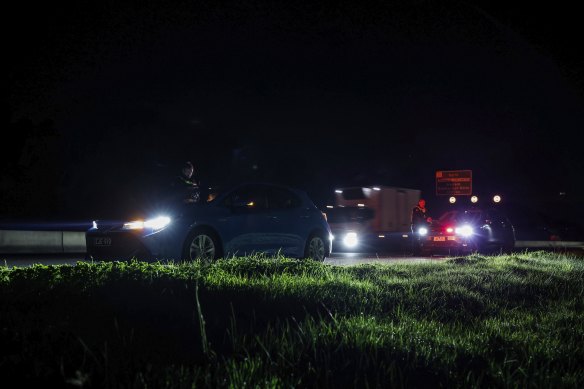
While most of Melbourne sleeps, for Trinity police it is peak hour.Credit: Darrian Traynor
The next night McKee sees the same car with different plates on the Monash Freeway. Again the thief drives off, reaching speeds of 150 km/h. Again he gets away, although it is pointless. He won the battle but has already lost the war. Police know the driver is one of their five most active offenders. He is 16 years old.
The following night police intercept four girls – two aged 14 and two aged 15 – along with a 12-year-old boy speeding in a stolen car. They run and try to hide. When arrested, they appeared to have enjoyed (literally) the thrill of the chase.
There is hope. They are not prolific offenders and have been arrested before they become ingrained in crime.
It is not a game. Families are left traumatised after home invasions and the consequences can be deadly. In July, trainee doctor Will Taylor, 28, was killed in a hit-and-run in Burwood, allegedly struck by a stolen car driven by a 17-year-old.
“We know we are always one car crash away from catastrophe. We have seen a number of close calls and one tragic case,” McKee says.
“We are the ones who have to tell the families.”
The book Naked City has been shortlisted for the prestigious Sydney Writers’ Festival Danger Awards, including in the People’s Choice section. Is it a wicked misuse of this column to urge readers to vote? Probably. Do we care? Probably not.